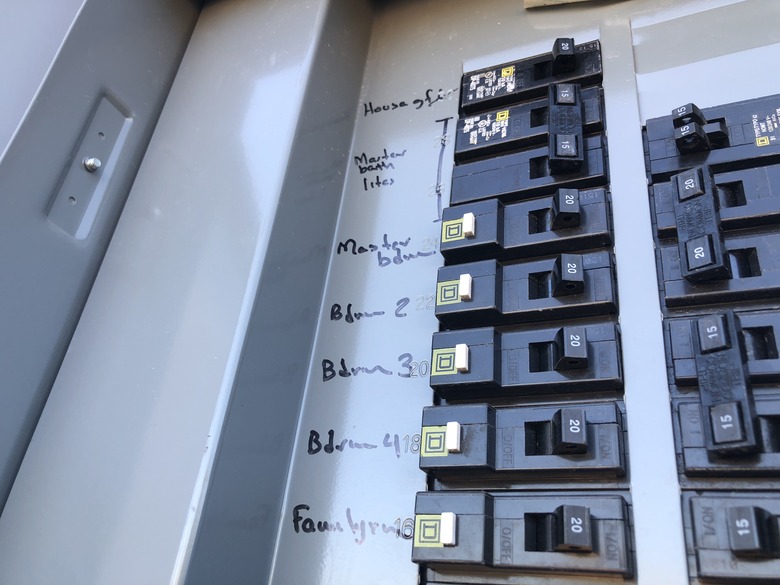How To Wire A 2-Pole 60-Amp Breaker
We may receive a commission on purchases made from links.
No matter your reason for needing to change or install a breaker, understanding the importance of its function is imperative. A circuit breaker protects the home's wiring against issues caused by high current, called amperes. Breakers need to be sized properly based on the need for the circuit. Along with the proper-size breaker for a specific circuit, the wire feeding the circuit needs to have the right amount of conductors as well as be sized to handle the load — in this case, 60 amperes.
Wiring a 2-Pole 60-Amp Breaker
1. Shut Off the Power
Securing the power to the entire panel is always the first step while working inside the breaker panel. Inform everyone in the house that the power will be disconnected. Shut off all the breakers one at a time and then turn off the main breaker.
2. Remove the Panel Cover
With the main circuit breaker off, carefully remove the panel cover by unscrewing the panel cover screws. Take care not to lose these screws.
3. Swap Out the Old Breaker for the New
If changing out a bad breaker, remove wiring from the old breaker. Carefully pry out the old breaker from the center and remove it by rolling outward. Insert the new breaker by reversing the removal process, making sure to lock the breaker firmly into the bus bar.
4. Attach the Wires
With the new breaker in place, reattach the two wires to the breaker, taking care not to overtighten the screws. If you are installing a new circuit with new wire, be sure to attach the ground wire, which is usually an uninsulated copper wire, to the grounded bus bar. If there is a neutral wire, be sure to attach it to a neutral bar.
While the power is off, it might be a good time to inspect any possible loose connections inside the panel. Take care to stay away from the main power lines feeding the panel.
5. Replace the Panel Cover
If you replaced an old breaker, replace the cover the same way you removed it. If you added another circuit to your panel, then you will need to remove the appropriate knock-outs for the new two-pole breaker.
6. Restore the Power
Once the cover is back on the breaker panel, turn on the power at the main circuit breaker first and then check your work by turning on the breaker you just replaced. After you are confident in your work replacing or installing the new circuit breaker, turn on the other breakers one at a time.
What Size Wire Is Needed for a 60-Amp Breaker?
What Size Wire Is Needed for a 60-Amp Breaker?
Wire size depends on a few important factors. First is the current or amperes for the circuit; in this case, it is 60 amps. Second is the length of run of the circuit. Another is the type of wire being used.
In the case of a 60-amp two-pole circuit, the wire will need to be two or three conductor 4AWG wire. This will give the maximum length of 209 feet at the recommended maximum voltage drop of 3 percent. Take note that 6-gauge wire is only rated for 55 amps, and some may use this size of wire for the 60-amp breaker based on the theory that the circuit will never see 60 amps. Choosing the right-size wire is critical for the safety of your home.
Tip
60-amp breakers require 4AWG (American wire gauge) wire. 4AWG wire is rated for 70 amps, whereas 6AWG is rated for 55 amps.
Double Pole Breakers
Double Pole Breakers
As the term "double" implies, there are two wire connections on a double pole breaker. These connections each carry a leg of power, combining it to deliver what is usually 240 volts. This increase in voltage gives larger appliances better efficiency, and this combined power is protected using a combination handle. The combination handle will trip both legs of power at the same time in the event of a problem with the circuit.
Some double pole circuits may have a neutral wire, like feeding a subpanel, for example. This neutral wire will give a path for lower-voltage circuits to complete the single leg circuits. No matter what kind of circuit you are wiring, an additional good solid ground is needed to the grounding bus bar.
100-Amp Panel Limitations
100-Amp Panel Limitations
A 100-amp panel has the capability of up to 42 circuits depending on the panel manufacturer. This is also limited by the 100 amps or 24,000 watts of power that should not be exceeded for safety.
